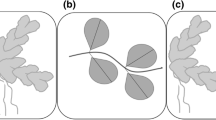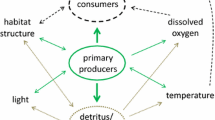Abstract
Rising carbon dioxide (CO2) concentrations are predicted to cause an undesirable transition from macroalgae-dominant to turf algae-dominant ecosystems due to its effect on community structuring processes. As turf algae are more likely to proliferate due to the CO2 fertilization effect than macroalgae and often inhibit macroalgal recruitment, increased CO2 beyond certain levels may produce novel positive feedback loops that promote turf algae growth and thus can stabilize turf algae-dominant ecosystems. In this study, we built a simple competition model between macroalgae and turf algae in a homogeneous space to investigate the steady-state response of the ecosystem to changes in the partial pressure of CO2 (pCO2). We found that discontinuous regime shifts in response to pCO2 change can occur once turf algae coverage reaches a critical level capable of inhibiting macroalgal recruitment. The effect of localized turf algae density on the success rate of macroalgae recruitment was also investigated using a patch model that simulated a two-dimensional heterogeneous space. This suggested that in addition to the inhibitory effect by turf algae, a self-enhancing effect by macroalgae could also be important in predicting the potential discontinuous regime shifts in response to future pCO2 changes.





Similar content being viewed by others
Data Availability
The numerical simulations upon which this study is based are too large to archive or to transfer. Instead, we provide all the information needed to replicate the simulations. The sample program for 2-D simulation is provided as a supplemental information.
References
Agostini S, Harvey BP, Wada S, Kon K, Milazzo M, Inaba K, Hall-Spencer JM (2018) Ocean acidification drives community shifts towards simplified non-calcified habitats in a subtropical− temperate transition zone. Scientific Reports 8(1):1–11
Agostini S, Harvey BP, Milazzo M et al (2021) Simplification, not “tropicalization”, of temperate marine ecosystems under ocean warming and acidification. Glob Change Biol. https://doi.org/10.1111/gcb.15749
Airoldi L (2003) The effects of sedimentation on rocky coast assemblages. Oceanogr Mar Biol. https://doi.org/10.1201/9780203180570.ch4
Allen RJ, Summerfield TC, Harvey BP et al (2021) Species turnover underpins the effect of elevated CO2 on biofilm communities through early succession. Climate Change Ecology. https://doi.org/10.1016/j.ecochg.2021.100017
Andrea Foo S, Byrne M, Ricevuto E, Cristina Gambi M (2018) The carbon dioxide vents of Ischia, Italy, a natural system to assess impacts of ocean acidification on marine ecosystems: an overview of research and comparisons with other vent systems. In: Oceanogr Mar Biol
Atkins PW (1998) Physical chemistry, 6th edn. Oxford University Press
Blackwood JC, Okasaki C, Archer A et al (2018) Modeling alternative stable states in Caribbean coral reefs. Nat Resour Model. https://doi.org/10.1111/nrm.12157
Carpenter S, Ludwig D, Brock W (1999) Management of eutrophication for lakes ubject to potentially irreversible change. Ecol Appl 9:751–771
Cattano C, Agostini S, Harvey BP et al (2020) Changes in fish communities due to benthic habitat shifts under ocean acidification conditions. Sci Total Environ. https://doi.org/10.1016/j.scitotenv.2020.138501
Connell SD, Doubleday ZA, Foster NR et al (2018) The duality of ocean acidification as a resource and a stressor. Ecology. https://doi.org/10.1002/ecy.2209
Connell SD, Kroeker KJ, Fabricius KE et al (2013) The other ocean acidification problem: CO2 as a resource among competitors for ecosystem dominance. Philos Trans R Soc B: Biol Sci. https://doi.org/10.1098/rstb.2012.0442
Connell SD, Russell BD (2010) The direct effects of increasing CO2 and temperature on non-calcifying organisms: increasing the potential for phase shifts in kelp forests. Proc R Soc B: Biol Sci 277:1409–1415. https://doi.org/10.1098/rspb.2009.2069
Cornwall CE, Revill AT, Hall-Spencer JM et al (2017) Inorganic carbon physiology underpins macroalgal responses to elevated CO2. Sci Rep. https://doi.org/10.1038/srep46297
deYoung B, Barange M, Beaugrand G et al (2008) Regime shifts in marine ecosystems: detection, prediction and management. Trends Ecol Evol 23
Eckman JE, Duggins DO, Sewell AT (1989) Ecology of under story kelp environments. I. Effects of kelps on flow and particle transport near the bottom. J Exp Mar Biol Ecol 129. https://doi.org/10.1016/0022-0981(89)90055-5
Falkenberg LJ, Connell SD, Russell BD (2013) Disrupting the effects of synergies between stressors: improved water quality dampens the effects of future CO2 on a marine habitat. J Appl Ecol 50:51–58. https://doi.org/10.1111/1365-2664.12019
Filbee-Dexter K, Wernberg T (2018) Rise of turfs: a new battlefront for globally declining kelp forests. Bioscience 68:64–76. https://doi.org/10.1093/biosci/bix147
Fung T, Seymour RM, Johnson CR (2011) Alternative stable states and phase shifts in coral reefs under anthropogenic stress. Ecology. https://doi.org/10.1890/10-0378.1
González-Delgado S, Hernández JC (2018) The importance of natural acidified systems in the study of ocean acidification: what have we learned? In: Adv Mar Biol
Gorman D, Connell SD (2009) Recovering subtidal forests in human-dominated landscapes. J Appl Ecol. https://doi.org/10.1111/j.1365-2664.2009.01711.x
Hall-Spencer JM, Harvey BP (2019) Ocean acidification impacts on coastal ecosystem services due to habitat degradation. Emerg Top Life Sci 3:197–206. https://doi.org/10.1042/ETLS20180117
Harvey BP, Agostini S, Kon K et al (2019) Diatoms dominate and alter marine food-webs When CO2 Rises. Diversity 11:242. https://doi.org/10.3390/d11120242
Harvey BP, Allen R, Agostini S et al (2021) Feedback mechanisms stabilise degraded turf algal systems at a CO2 seep site. Commun Biol 4:5–10. https://doi.org/10.1038/s42003-021-01712-2
Harvey BP, Kon K, Agostini S et al (2021b) Ocean acidification locks algal communities in a species-poor early successional stage. Glob Change Biol. https://doi.org/10.1111/gcb.15455
Hepburn CD, Pritchard DW, Cornwall CE et al (2011) Diversity of carbon use strategies in a kelp forest community: implications for a high CO2 ocean. Glob Change Biol. https://doi.org/10.1111/j.1365-2486.2011.02411.x
Hughes TP, Rodrigues MJ, Bellwood DR et al (2007) Phase shifts, herbivory, and the resilience of coral reefs to climate change. Curr Biol. https://doi.org/10.1016/j.cub.2006.12.049
Itou T, Kanno M, Suyama Y et al (2019) Opening the black box: microspatial patterns of zoospore dispersal, parentage, and selfing in the kelp Ecklonia cava as revealed by microsatellite markers. J Appl Phycol 31:3283–3294. https://doi.org/10.1007/s10811-019-01790-0
Johnson VR, Russell BD, Fabricius KE et al (2012) Temperate and tropical brown macroalgae thrive, despite decalcification, along natural CO 2 gradients. Glob Change Biol 18:2792–2803. https://doi.org/10.1111/j.1365-2486.2012.02716.x
Jouffray JB, Nyström M, Norström AV et al (2015) Identifying multiple coral reef regimes and their drivers across the Hawaiian archipelago. Philos Trans R Soc B: Biol Sci. https://doi.org/10.1098/rstb.2013.0268
Kennelly SJ (1987) Inhibition of kelp recruitment by turfing algae and consequences for an Australian kelp community. J Exp Mar Biol Ecol. https://doi.org/10.1016/S0022-0981(87)80014-X
Kinnby A, White JCB, Toth GB, Pavia H (2021) Ocean acidification decreases grazing pressure but alters morphological structure in a dominant coastal seaweed. PLoS One 16:1–14. https://doi.org/10.1371/journal.pone.0245017
Koch M, Bowes G, Ross C, Zhang XH (2013) Climate change and ocean acidification effects on seagrasses and marine macroalgae. Glob Chang Biol 19
Layton C, Cameron MJ, Shelamoff V et al (2019) Chemical microenvironments within macroalgal assemblages: implications for the inhibition of kelp recruitment by turf algae. Limnol Oceanogr 64:1600–1613. https://doi.org/10.1002/lno.11138
McManus LC, Watson JR, Vasconcelos VV, Levin SA (2019) Stability and recovery of coral-algae systems: the importance of recruitment seasonality and grazing influence. Thyroid Res. https://doi.org/10.1007/s12080-018-0388-x
Moy FE, Christie H (2012) Large-scale shift from sugar kelp (Saccharina latissima) to ephemeral algae along the south and west coast of Norway. Mar Biol Res. https://doi.org/10.1080/17451000.2011.637561
Mumby PJ, Hastings A, Edwards HJ (2007) Thresholds and the resilience of Caribbean coral reefs. Nature. https://doi.org/10.1038/nature06252
Nagelkerken I, Russell BD, Gillanders BM, Connell SD (2016) Ocean acidification alters fish populations indirectly through habitat modification. Nat Clim Chang. https://doi.org/10.1038/nclimate2757
Nunes J, Mccoy SJ, Findlay HS et al (2016) Two intertidal, non-calcifying macroalgae (Palmaria palmata and Saccharina latissima) show complex and variable responses to short-term CO2 acidification. ICES J Mar Sci 73:887–896
O’Brien JM, Scheibling RE (2018) Turf wars: competition between foundation and turf-forming species on temperate and tropical reefs and its role in regime shifts. Mar Ecol Prog Ser 590:1–17. https://doi.org/10.3354/meps12530
Pessarrodona A, Filbee-Dexter K, Alcoverro T et al (2021) Homogenization and miniaturization of habitat structure in temperate marine forests. Glob Change Biol. https://doi.org/10.1111/gcb.15759
Rastrick SSP, Graham H, Azetsu-Scott K et al (2018) Using natural analogues to investigate the effects of climate change and ocean acidification on Northern ecosystems. ICES J Mar Sci. https://doi.org/10.1093/icesjms/fsy128
Reed DC, Foster MS (2014) The effects of canopy shadings on algal recruitment and growth in a giant kelp forest. Ecology 65:937–948
Scheffer M, Carpenter SR (2003) Catastrophic regime shifts in ecosystems: linking theory to observation. Trends Ecol Evol 18:648–656
Steen H, Scrosati R (2004) Intraspecific competition in Fucus serratus and F. evanescens (Phaeophyceae: Fucales) germlings: effects of settlement density, nutrient concentration, and temperature. Mar Biol 144. https://doi.org/10.1007/s00227-003-1175-8
Stocker TF, Qin D, Plattner GK et al (2013) Climate change 2013 the physical science basis: working Group I contribution to the fifth assessment report of the intergovernmental panel on climate change
Strain EMA, Thomson RJ, Micheli F et al (2014) Identifying the interacting roles of stressors in driving the global loss of canopy-forming to mat-forming algae in marine ecosystems. Glob Change Biol. https://doi.org/10.1111/gcb.12619
Suding KN, Gross KL, Houseman GR (2004) Alternative states and positive feedbacks in restoration ecology. Trends Ecol Evol 19:46–53. https://doi.org/10.1016/j.tree.2003.10.005
Sunday JM, Fabricius KE, Kroeker KJ et al (2017) Ocean acidification can mediate biodiversity shifts by changing biogenic habitat. Nat Clim Chang. https://doi.org/10.1038/nclimate3161
Tatsumi M, Layton C, Cameron MJ et al (2021) Interactive effects of canopy-driven changes in light, scour and water flow on microscopic recruits in kelp. Mar Environ Res 171:105450. https://doi.org/10.1016/j.marenvres.2021.105450
Teixidó N, Gambi MC, Parravacini V et al (2018) Functional biodiversity loss along natural CO2 gradients. Nat Commun. https://doi.org/10.1038/s41467-018-07592-1
Wernberg T, Bennett S, Babcock RC et al (2016) Climate-driven regime shift of a temperate marine ecosystem. Science. https://doi.org/10.1126/science.aad8745
Wernberg T, Kendrick GA, Toohey BD (2005) Modification of the physical environment by an Ecklonia radiata (Laminariales) canopy and implications for associated foliose algae. Aquat Ecol 39:419–430. https://doi.org/10.1007/s10452-005-9009-z
Young CS, Gobler CJ (2016) Ocean acidification accelerates the growth of two bloom-forming macroalgae. PLoS One 11:1–21. https://doi.org/10.1371/journal.pone.0155152
Acknowledgements
We are thankful to two anonymous reviewers for their constructive comments.
Funding
This work was supported by Japan Society for the Promotion of Science (JSPS) KAKENHI Grant Number 19H04234 and was partially funded by the Japan Society for the Promotion of Science (JSPS) Core-to-Core Program (Grant Number: JPJSCCA20210006). This project contributes towards the International CO2 Natural Analogues (ICONA) Network.
Author information
Authors and Affiliations
Contributions
All authors contributed to the study conception and design. Modeling, simulation, and analysis were performed by MS. The first draft of the manuscript was equally written by MS and BPH, and all authors commented on previous versions of the manuscript. All authors read and approved the final manuscript.
Corresponding author
Ethics declarations
Competing interests
The authors declare no competing interests.
Supplementary Information
ESM 1
(ZIP 90.9 kb)
Rights and permissions
Springer Nature or its licensor (e.g. a society or other partner) holds exclusive rights to this article under a publishing agreement with the author(s) or other rightsholder(s); author self-archiving of the accepted manuscript version of this article is solely governed by the terms of such publishing agreement and applicable law.
About this article
Cite this article
Seto, M., Harvey, B.P., Wada, S. et al. Potential ecosystem regime shift resulting from elevated CO2 and inhibition of macroalgal recruitment by turf algae. Theor Ecol 16, 1–12 (2023). https://doi.org/10.1007/s12080-022-00550-0
Received:
Accepted:
Published:
Issue Date:
DOI: https://doi.org/10.1007/s12080-022-00550-0




